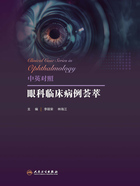
病例22 65岁老年女性,主诉右眼眼红、眼痛、流泪6天
CASE 22 A 65-year-old female with left eye redness, pain and tearing for 6 days
见图1-37。See Fig. 1-37.

图1-37 结膜混合充血,全角膜上皮水肿增厚,浅层基质浸润Fig. 1-37 Mixed congestion of conjunctiva, swollen corneal epithelium and inf iltration of corneal stroma
鉴别诊断
Differential Diagnosis
◎ 药源性角结膜炎:药源性角结膜炎临床表现不具备特异性,角膜病变表现多样复杂,须仔细加以鉴别。大多数患者有长期眼局部用药史。病毒性角结膜炎、青光眼及不明原因的角膜炎是药源性角结膜炎的最常见原发病,因为这些病往往需要长时间眼部用药。
◎ Drug-induced keratoconjunctivitis: Clinical man i f e stations of drug-induced keratoconjunctivitis are not specif ic. Manifestations are diverse and complex,which need to be carefully identif ied. Most patients had a long-term topical medication history for chronic eye diseases such as viral ker a t o c o n j u n c t i v itis, glaucoma, and unexplained keratitis.
◎ 神经营养性角膜炎:神经营养性角膜炎是一种以上皮延迟愈合为特征的角膜上皮营养性疾病,该病的特征是角膜知觉缺失,并可能最终引起角膜基质融解和穿孔。
◎ Neurotrophic keratitis: Neurotrophic keratitis is a corneal dystophy, caused by delayed healing of cornea epithelium. It is characterized by loss of corneal perception and may eventually result in corneal stromal dissolution and perforation.
◎ 感染性角膜炎:不同病原体所致的感染性角膜炎都有其临床特点,可以根据这些特点鉴别,寻找病原体也是鉴别诊断的重要环节。
◎ Infectious keratitis: Infectious keratitis caused by different pathogens can be identif ied according to their clinical characteristics, looking for pathogens is most important for differential diagnosis.
病史询问
Asking History
◎ 眼病史:尤其是干眼、病毒性角膜炎、青光眼等病史。
◎ History of eye disease: Especially the history of dry eye,viral keratitis, and glaucoma.
◎ 眼部滴眼液使用的类型和频率。
◎ Type and frequency of eye drops used with ocular toxicity.
◎ 眼部手术或外伤史。
◎ History of surgeries or trauma.
◎ 全身性疾病、病毒感染史,化学物品或角膜接触镜护理液暴露史,免疫系统疾病史,颅脑手术史。
◎ Systemic disease with ocular manifestations, history of viral infections, exposure to chemical or contact lenses solutions, immune system disorder, cranial surgery history.
眼部检查
Examination
◎ 视力、眼压。
◎ Visual acuity and IOP.
◎ 裂隙灯检查:荧光素染色检查角膜上皮缺损情况。
◎ Slit lamp examination: Fluorescein staining was utilized for detecting epithelium defect.
◎ 共聚焦显微镜检查:除外真菌、阿米巴等感染性角膜炎,观察炎症细胞种类、分布及活化情况辅助诊断。
◎ Confocal microscope: To exclude fungal, amoeba and other infectious keratitis. Types, distribution and activation of inf lammatory cells were observed to assist diagnosis.
诊断
Diagnosis
药源性角结膜炎。
Drug-induced keratoconjunctivitis.
治疗
Management
◎ 停止眼局部用药:对于高度怀疑药源性角结膜炎的患者,立即停止所有可能具有眼部毒性的滴眼液。
◎ For patients with highly suspected drug-induced kerat o c onjunctivitis, stop using all potentially toxic eye drops immediately.
◎ 角膜修复治疗:程度较轻者可使用不含防腐剂的人工泪液或小牛血去蛋白提取物等促进角膜上皮修复,严重者须使用自体血清促进角膜上皮愈合。
◎ Cornea plerosis: Topical preservative free artif icial tears and autologous serum could accelerate corneal epithelial wound healing.
◎ 原发病治疗:对于有原发病不能停药的患者,应尽量使用不含防腐剂或低毒性防腐剂的剂型,同时调整用药,在治疗原发病的同时,尽量降低使用频次和药品种类以及减少使用时间。
◎ Primary disease treatment: If patients with primary disease cannot stop medicines, preservative free or low toxic preservatives dosage forms should be used as far as possible. Frequency, type and duration of eye drops for primary desease should be minimized.
◎ 抗炎治疗:炎症反应较重者可酌情使用类固醇抗炎治疗。
◎ Anti-inf lammatory: Topical steroids can be added for severe inf lammatory response cases.
◎ 预防性抗生素:对于上皮持续缺损的患者,可给予预防性抗生素,避免继发感染。
◎ Prophylactic antibiotics: For patients with persistent epithelial defects, prophylactic antibiotics should be given to avoid secondary infections.
◎ 角膜上皮持续不愈合者可考虑角膜接触镜治疗或羊膜移植手术治疗。
◎ In severe cases, contact lens and surgery (amniotic membrane transplant) should be considered.
患者教育和预后
Patients Education & Prognosis
◎ 药源性角结膜炎必须以预防为主。须告知患者不可随意自行使用眼局部药物治疗,对于原发性疾病必须用药的情况,须在医生的指导下尽量使用不含防腐剂的药物,避免防腐剂对眼表的进一步损伤。眼表恢复可能需要几周甚至几个月的时间,多数预后良好。一些严重的病例,角膜残留瘢痕致视力永久下降。
◎ Prevention is better than treating drug-induced keratoconjunctivitis. It is necessary to inform the patient not to use ophthalmic drugs at will. When the primary diseases must be treated with drugs, the drugs without preservatives should be used as far as possible under the guidance of the doctor to avoid further damage to the ocular surface caused by preservatives. It may take weeks or even months for the ocular surface to recover, and most of them have a good prognosis. In severe cases, the residual scar of cornea can cause the permanent vision lost.